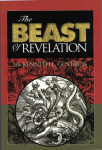We are not looking for your novel theories here.
You are invited to read and interact to what is offered in the links, thank you in advance!
LITERALISM AND POSTMILLENNIALISM
Reader question:
I have a question for you. I recently heard a postmill/amill debate. The amill gave a criticism against postmill that I am really stuck on. Maybe you can help.
He said that postmills apply the restoration Psalms and prophecies like dispensationalists do, in a literalistic, types and shadows fashion. For example, regarding Psalm 2:8 the amill said that postmills apply the terms “nations” and “earth” in a way that Jesus and the apostles never intended (political entities, etc.). From his perspective, the NT teaches that for Christ to make the nations and earth His footstool refers to the salvation of the Gentiles from every tribe tongue and nation, not Christ’s influence on political structures, etc.
I think this is a good argument and I am a bit stumped. Can you help me?
J.B.
My reply:
Thanks for your question. I don’t see where the problem is in this critique of postmillennialism. I would note the following:
(paperback by Kenneth Gentry)
A classic, thorough explanation and defense of postmillennialism (600+ pages). Complete with several chapters answering specific objections.
See more study materials at: www.KennethGentry.com
The Scriptures are not one-dimensional. They employ a variety of communicative forms and cover a broad range of literary types. We must check each text according to its context and its intended meaning.
Technical studies on key issues in Revelation, including the seven-sealed scroll, the cast out temple, Jewish persecution of Christianity, the Babylonian Harlot, and more.
See more study materials at: www.KennethGentry.com
You are invited to read and interact to what is offered in the links, thank you in advance!
LITERALISM AND POSTMILLENNIALISM
Reader question:
I have a question for you. I recently heard a postmill/amill debate. The amill gave a criticism against postmill that I am really stuck on. Maybe you can help.
He said that postmills apply the restoration Psalms and prophecies like dispensationalists do, in a literalistic, types and shadows fashion. For example, regarding Psalm 2:8 the amill said that postmills apply the terms “nations” and “earth” in a way that Jesus and the apostles never intended (political entities, etc.). From his perspective, the NT teaches that for Christ to make the nations and earth His footstool refers to the salvation of the Gentiles from every tribe tongue and nation, not Christ’s influence on political structures, etc.
I think this is a good argument and I am a bit stumped. Can you help me?
J.B.
My reply:
Thanks for your question. I don’t see where the problem is in this critique of postmillennialism. I would note the following:
- We must be careful not to throw out all literalism just because dispensationalists wrongly use it. Clearly many prophecies are to be interpreted literally. Perhaps the virgin birth is the best example of a literal prophecy — in that it involves one of the fundamentals of the faith by impacting the pre-existence and deity of Christ.
(paperback by Kenneth Gentry)
A classic, thorough explanation and defense of postmillennialism (600+ pages). Complete with several chapters answering specific objections.
See more study materials at: www.KennethGentry.com
The Scriptures are not one-dimensional. They employ a variety of communicative forms and cover a broad range of literary types. We must check each text according to its context and its intended meaning.
- Of course, the particular matter you bring up, does involve a particular text and context. You specifically mention Psalm 2:8. So here we have a concrete example, which is much better than an abstract principle.
- In addition, I would note that David calls upon the kings and judges of the earth to do homage to the Son (Psa 2:10-12). It seems he goes to great lengths to speak of not only people in general (nations and ends of the earth) but even their political rulers and judges. This leads me to believe that he does have nations as such in view. We surely do not believe that God has no interest in political structures and kingdoms.Navigating the Book of Revelation: Special Studies on Important Issues is the first book produced from Dr. Gentry’s Revelation Commentary Project’s research. In it the student of Revelation will find fifteen special studies on key issues for working his way through John’s mysterious book. Some of the studies are technical studies; some are more general. All offer important insights into the preterist interpretation of Revelation.
In this work you will see how John put on the mantle of the Old Testament prophet to confront Israel in her rebellion. You will understand his anger with Israel, paralleling John the Baptist, Jeremiah, Isaiah, and Ezekiel
You will learn how he denounces Israel for her persecuting Christians and how he “excommunicates” the temple as an idol for Israel. You will learn much about Israel’s involvement with Rome against young Christianity. You will also find answers to perplexing questions, such as: “Why did John send such a Hebraic book to Asian Christians?”
- In addition, I would note that David calls upon the kings and judges of the earth to do homage to the Son (Psa 2:10-12). It seems he goes to great lengths to speak of not only people in general (nations and ends of the earth) but even their political rulers and judges. This leads me to believe that he does have nations as such in view. We surely do not believe that God has no interest in political structures and kingdoms.Navigating the Book of Revelation: Special Studies on Important Issues is the first book produced from Dr. Gentry’s Revelation Commentary Project’s research. In it the student of Revelation will find fifteen special studies on key issues for working his way through John’s mysterious book. Some of the studies are technical studies; some are more general. All offer important insights into the preterist interpretation of Revelation.
Technical studies on key issues in Revelation, including the seven-sealed scroll, the cast out temple, Jewish persecution of Christianity, the Babylonian Harlot, and more.
See more study materials at: www.KennethGentry.com
- Besides all of this, reducing the significance of Psa 2 would not affect the broader argument for postmillennialism. Postmillennialism is not a “one text” eschatological system (as premillennialism tends to be with Rev 20). We have a great number of texts from Genesis through Revelation that promote an optimistic view of the unfolding of history.
Last edited:




































